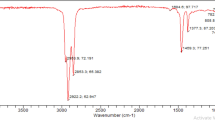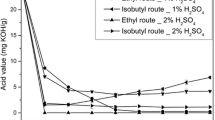Abstract
Biodiesels were prepared according to standard procedures from unrefined oils of eight commercially available peanut cultivars and compared for differences in physical properties important to fuel performance. Dynamic viscosity, kinematic viscosity and density were measured from 100 to 15 °C, and differences (p < 0.05) in these physical properties occurred more frequently at lower temperatures when comparing the different cultivars. Unlike data for the oil feedstocks, no meaningful correlations among biodiesel fatty acid profiles and either fuel viscosity or density were observed. Low temperature crystallization of the peanut biodiesels was measured via differential scanning calorimetry. Increased concentrations of long chain saturated fatty acid methyl esters (FAME) were associated with an increased propensity for low temperature crystallization, and the single FAME category most associated with low temperature crystallization was C:24. Tempering at 10 °C followed by analysis of the soluble fractions (winterization), improved crystallization properties and confirmed the importance that long chain saturated FAMEs play in the final functionality of peanut biodiesel. Peanut data is also compared to data for canola and soy biodiesels, as these feedstocks are more common worldwide for biodiesel production. Overall, this work suggests that minimizing the concentration of long chain saturated FAMEs within peanut biodiesel, either through processing and/or breeding efforts would improve the low temperature performance of peanut biodiesel.





Similar content being viewed by others
References
Fukuda H, Kondo A, Noda H (2001) Biodiesel fuel production by transesterification of oils. J Biosci Bioeng 92:405–416
Ma FR, Hanna MA (1999) Biodiesel production: a review. Bioresour Technol 70:1–15
Goodrum JW, Geller DP (2005) Influence of fatty acid methyl esters from hydroxylated vegetable oils in diesel fuel lubricity. Bioresour Technol 96:851–855
Davis JP, Dean LO, Faircloth WH, Sanders TH (2008) Physical and chemical characterizations of normal and high-oleic oils from nine commercial cultivars of peanut. J Am Oil Chem Soc 85:235–243
Davis JP, Sanders TH (2007) Liquid to semisolid rheological transitions of normal and high-oleic peanut oils upon cooling to refrigeration temperatures. J Am Oil Chem Soc 84:979–987
Sivakumaran K, Goodrum JW, Bradley RA (1985) Expeller optimization for peanut oil production. Trans ASAE 28:316–320
ASTM d 7042-04 Standard test method for dynamic viscosity and density of liquids by stabinger viscometer (and the calculation of kinematic viscosity)
Bannon CD, Craske JD, Hai NT, Harper NL, Orourke KL (1982) Analysis of fatty-acid methyl-esters with high-accuracy and reliability. 2. Methylation of fats and oils with boron trifluoride-methanol. J Chromatog 247:63–69
Canakci M, Sanli H (2008) Biodiesel production from various feedstocks and their effects on the fuel properties. J Ind Microbiol Biotechnol 35:431–441
Geller DP, Goodrum JW (2000) Rheology of vegetable oil analogs and triglycerides. J Am Oil Chem Soc 77:111–114
Tat ME, Van Gerpen JH (1999) The kinematic viscosity of biodiesel and its blends with diesel fuel. J Am Oil Chem Soc 76:1511–1513
Joshi RM, Pegg MJ (2007) Flow properties of biodiesel fuel blends at low temperatures. Fuel 86:143–151
Krisnangkura K, Yimsuwan T, Pairintra R (2006) An empirical approach in predicting biodiesel viscosity at various temperatures. Fuel 85:107–113
Tate RE, Watts KC, Allen CAW, Wilkie KL (2006) The viscosities of three biodiesel fuels at temperatures up to 300 degrees C. Fuel 85:1010–1015
Watanabe Y, Shimada Y, Sugihara A, Tominaga Y (2002) Conversion of degummed soybean oil to biodiesel fuel with immobilized candida Antarctica lipase. J Mol Catal B-Enzym 17:151–155
Knothe G, Steidley KR (2005) Kinematic viscosity of biodiesel fuel components and related compounds. Influence of compound structure and comparison to petrodiesel fuel components. Fuel 84:1059–1065
Geller DP, Adams TT, Goodrum JW, Pendergrass J (2008) Storage stability of poultry fat and diesel fuel mixtures: specific gravity and viscosity. Fuel 87:92–102
Geller DP, Goodrum JW (2004) Effects of specific fatty acid methyl esters on diesel fuel lubricity. Fuel 83:2351–2356
Lee I, Johnson LA, Hammond EG (1995) Use of branched-chain esters to reduce the crystallization temperature of biodiesel. J Am Oil Chem Soc 72:1155–1160
Dunn RO (1999) Thermal analysis of alternative diesel fuels from vegetable oils. J Am Oil Chem Soc 76:109–115
Claudy P, Letoffe JM, Neff B, Damin B (1986) Diesel fuels—determination of onset crystallization temperature, pour point and filter plugging point by differential scanning calorimetry—correlation with standard test methods. Fuel 65:861–864
Rodrigues JD, Cardoso FD, Lachter ER, Estevao LRM, Lima E, Nascimento RSV (2006) Correlating chemical structure and physical properties of vegetable oil esters. J Am Oil Chem Soc 83:353–357
Oda M, Ueno T, Kasai N et al (2002) Inhibition of telomerase by linear-chain fatty acids: a structural analysis. Biochem J 367:329–334
Author information
Authors and Affiliations
Corresponding author
About this article
Cite this article
Davis, J.P., Geller, D., Faircloth, W.H. et al. Comparisons of Biodiesel Produced from Unrefined Oils of Different Peanut Cultivars. J Am Oil Chem Soc 86, 353–361 (2009). https://doi.org/10.1007/s11746-009-1353-z
Received:
Revised:
Accepted:
Published:
Issue Date:
DOI: https://doi.org/10.1007/s11746-009-1353-z




